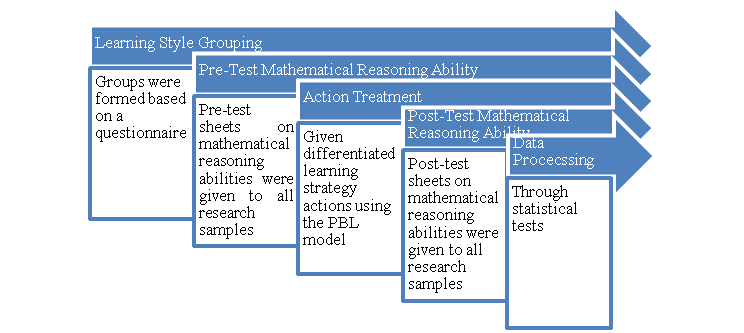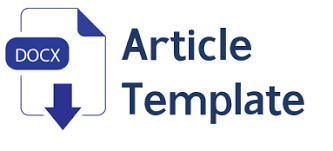Differentiated Differentiated learning with problem-based learning model in enhancing mathematical reasoning ability viewed from learning styles
Keywords:
Differentiated learning strategies, Problem-based learning, Mathematical reasoning ability, Visual learning style, Auditory learning style, Kinesthietic learning style, Triangles and special lines in trianglesAbstract
This study examines the differences in students' mathematical reasoning abilities regarding triangles and special lines before and after implementing differentiated learning strategies using the Problem-Based Learning (PBL) model. It also explores how students' learning styles—visual, auditory, and kinesthetic—affect their mathematical reasoning outcomes. Conducted in a private junior high school in Sukabumi Regency, the quantitative experimental study involved 32 eighth-grade students. Participants were categorized based on their learning styles and class performance. Data collection included mathematics tests and interviews, analyzed through triangulation. Prior to treatment, 56% of students were identified as visual learners, while 22% were auditory and 22% kinesthetic. Following the pre-test on mathematical reasoning and PBL treatment, post-test results showed a significant improvement in students' abilities. The auditory learning style group achieved the highest average post-test score of 65.071. Contributing factors included: 1) greater engagement in discussions among auditory learners, who are naturally inclined to communicate, allowing for immediate resolution of misunderstandings; 2) more robust discussion activities within the auditory group; 3) auditory students' strengths in verbal tasks and receptive skills for verbal instructions; and 4) their ability to effectively convey information through oral and written communication, enhancing the quality of discussions. Overall, the findings suggest that differentiated learning through the PBL model positively impacts mathematical reasoning, particularly for auditory learners.
References
Al-Hamzah, I. N. F., & Awalludin, S. A. (2021). Analisis kemampuan pemecahan masalah matematis ditinjau dari gaya belajar siswa di masa pandemi covid-19. Jurnal Cendekia: Jurnal Pendidikan Matematika, 5(3), 2246-2254. https://doi.org/10.31004/cendekia.v5i3.832
Cindyana, E.A., Alim, J.A., & Noviana, E.,. (2022). Pengaruh pembelajaran berdiferensiasi berbantuan materi ajar geometri berbasis RME terhadap kemampuan penalaran matematis siswa kelas 3 sekolah dasar. JURNAL PAJAR (Pendidikan dan Pengajaran), 6. 1179. https://doi.org/10.33578/pjr.v6i4.8837
Damayanti, P. A., & Qohar, A. (2019). Pengembangan media pembelajaran matematika interaktif berbasis powerpoint pada materi kerucut. Kreano, Jurnal Matematika Kreatif-Inovatif, 10(2), 119-124. https://doi.org/10.15294/kreano.v10i2.16814
Hasibuan, M., Minarti, A., & Amry, Z. (2022). Pengaruh kemampuan awal matematis dan model pembelajaran (PjBL dan PBL) terhadap kemampuan penalaran matematis dan disposisi matematis siswa. Jurnal Cendekia: Jurnal Pendidikan Matematika, 6(2), 2298-2317. https://doi.org/10.31004/cendekia.v6i2.1487
Lestari, E.L, & Yudhanegara, M.R. (2015). Penelitian pendidikan matematika. Bandung: PT. Refika Aditama.
Marfu’ah, S., Zaenuri, Z., Masrukan, M., & Walid, W. (2022). Model pembelajaran matematika untuk meningkatkan kemampuan penalaran matematis siswa. PRISMA, Prosiding Seminar Nasional Matematika, 5, 50-54. https://journal.unnes.ac.id/sju/prisma/article/view/54339
Mullis, I. V. S., Martin, M. O. Ruddock, G. J., O'Sullivan, C. Y. & Preuschoft, C. (2009). TIMSS 2011 Mathematics Framework. Amsterdam: TIMSS & PIRLS International Study Center Lynch School of Education, Boston College.
Nur’azizzah, N., Pramuditya, S.A., & Rosita, C.D.. (2023). Analisis kemampuan penalaran matematis siswa melalui pendekatan pembelajaran berdiferensiasi. JUMLAHKU: Jurnal Matematika Ilmiah STKIP Muhammadiyah Kuningan, 9(1), 13-20. https://doi.org/10.33222/jumlahku.v9i1.2744
OECD. (2016). PISA 2015 Result in focus. 14 Maret 2024, https://www.oecd.org/pisa/pisa-2015-result-in-focus.pdf
OECD. (2013). PISA 2022 Result in focus. 14 Maret 2024, https://www.oecd.org/publication/pisa-2022-results/country-notes/indonesia-c2e1ae0e/#chapter-d1e11
PISA. (2019). OECD Multilingual summaries PISA 2018 Results (Volume I ) What Students Know and Can Do Resultados de PISA 2018 (Volumen I) Lo que los estudiantes saben y pueden hacer Lo que los estudiantes saben y pueden hacer: conclusiones principales. I(Volume I), 2018–2020. 14 Maret 2024, https://www.oecd-ilibrary.org/docserver/a89c90e1-es.pdf?expires=1596231234&id=id&accname=guest&checksum=D1296FBB63BED1CFB573C9D710E87BE9
Purbaningrum, K. A. (2017). Kemampuan berpikir tingkat tinggi siswa smp dalam pemecahan masalah matematika ditinjau dari gaya belajar. Jurnal Penelitian Dan Pembelajaran Matematika, 10(2). https://dx.doi.org/10.30870/jppm.v10i2.2029
Rhofiqah, L., & Thaariq, S. M. H. (2019). Pengaruh model pembelajaran problem based learning (PBL) terhadap kemampuan penalaran matematik siswa kelas XI SMA Negeri I Meurebo. Bionatural: Jurnal Ilmiah Pendidikan Biologi, 6(1). https://garuda.kemdikbud.go.id/documents/detail/1289625
Sarie, F. N. (2022). Implementasi pembelajaran berdiferensiasi dengan model problem based learning pada siswa sekolah dasar kelas VI. Tunas Nusantara, 4(2), 492-498.
Shadiq, F. (2014). Pembelajaran Matematika; Cara Meningkatkan Kemampuan Berpikir Siswa. Tangerang: Graha Ilmu
Sokolowski, A. (2018). The effects of using representations in elementary mathematics: Meta-analysis of research. IAFOR Journal of Education. 6 (3), 129–152. https://doi.org/10.22492/ije.6.3.08
Sugianto, A. (2021). Kuesioner gaya belajar siswa. https://repo-dosen.ulm.ac.id/bitstream/handle/123456789/26041/Angket%20Gaya%20Belajar%202021.pdf?sequence=1&isAllowed=y
Sugiyono. (2014). Metode penelitian kuantitatif, kualitatif, dan R&D. Bandung: ALFABETA.
Sugiyono. (2015). Metode penelitian kuantitatif, kualitatif, dan R&D. Bandung: ALFABETA.
Sugiyono. (2016). Metode penelitian kuantitatif, kualitatif, dan R&D. Bandung: ALFABETA.
Sugiyono. (2019). Metode penelitian kuantitatif, kualitatif, dan R&D. Bandung: ALFABETA.
Supit, D., Melianti, M., Lasut, E. M. M., & Tumbel, N. J. (2023). Gaya belajar visual, auditori, kinestetik terhadap hasil belajar siswa. Journal on Education, 5(3), 6994-7003. https://doi.org/10.31004/joe.v5i3.1487
Tomlinson, C. A. (2001). How to differentiate instruction in mixed-ability classrooms. ASCD. Tomlinson. (Modul 2.1 PGP, 2020).
Wahyudi, I. D., & Walid, W. (2020). Mathematical reasoning ability of students based on learning style using missouri mathematics project learning model. Unnes Journal of Mathematics Education, 9(3), 206-210. https://doi.org/10.15294/ujme.v9i3.44538
Wirabumi, R. (2020). Metode pembelajaran ceramah. Annual Conference on Islamic Education and Thought (ACIET), 1(1), 105-113. https://pkm.uika-bogor.ac.id/index.php/aciet/article/view/660
Yuwanita, I., Dewi, H. I., & Wicaksono, D. (2020). Pengaruh metode pembelajaran dan gaya belajar terhadap hasil belajar IPA. Instruksional, 1(2), 152-158. https://doi.org/10.24853/instruksional.1.2.152-158

Downloads
Published
How to Cite
Conference Proceedings Volume
Section
License
Copyright (c) 2024 Rakha Pradestya, Jenisus O. Dejarlo, Sudirman, Ardi Dwi Susandi

This work is licensed under a Creative Commons Attribution-ShareAlike 4.0 International License.











